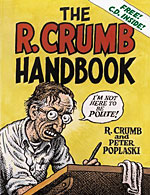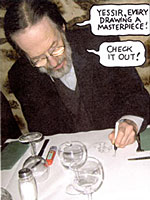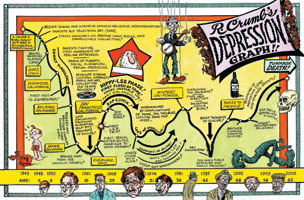>> Top Nine: Yusuf's Choice
>> Alphabetti Fumetti: S is for Shooter
More...

 Writers: R Crumb, Pete Poplaski
Writers: R Crumb, Pete Poplaski
Artist: R Crumb
Price: $25.00
Publisher: Mq Publishing
ISBN: 1840727160
Robert Crumb is a sick, twisted, fucked up misanthrope. He is a man whose character is built upon the solid foundations of bitterness, self-loathing, mockery and cynicism.
To say as much isn't a criticism or a personal attack, it's an echo of the way that Crumb has chosen to present himself through his work, the very same characteristics that have enabled him to become "America's Greatest Living Cartoonist, TM". Simply put, if Crumb were a normal, well-adjusted human being, it's extremely unlikely that he'd have found any kind of success or recognition as an artist.
It is this fascinating contradiction, the incongruity between art and happiness, which is most striking upon reading THE R CRUMB HANDBOOK. Released to coincide with a recent exhibition at the Whitechapel Art Gallery in London, it is a handsomely bound memoir that intersperses personal commentary with artwork from the most important stages of his life. It's a big, fat, chunky doorstopper of a book, heavy enough to brain a horse, but the thick pages and large font won't take long to read. Short but sweet, it makes for a strange journey into the inky black depths of a tortured soul.
Split into four sections - Fear, Clarity, Power and Old Age - Crumb talks us through his difficult childhood, his experiences in the 60s with drugs and the counter-culture, being embraced by the establishment, and his ruminations on death.
For newcomers to his work this makes a useful primer on everything weird and wonderful about Robert Crumb. All the usual characters are here; Mister Natural, Devil Girl, Fritz the Cat, Angelfood McSpade, plus numerous strips featuring Crumb himself as a tall, gangly outcast with thick glasses, buck-teeth and a protruding Adam's apple. For long-term aficionados the book functions as an extension of Terry Zwigoff's documentary from 1994, filling in the blanks regarding Crumb's early life and how he and his family have dealt with celebrity in the wake of that film's tremendous popularity.
It's very interesting, for example, to note how Crumb's life has been book-ended by working collaboratively with people he is (or was) especially close to. In his youth he was press-ganged into writing and drawing cartoons by his older brother Charles, who committed suicide in the early 90s, and together they produced hundreds of comics that featured intricate dialogue, plots and sequences.
 In the present day Crumb resides in the south of France with his wife, Aline Kominsky-Crumb, and the pair create comics about their life together, each drawing themselves into the strip with styles that are radically different. Examples of both collaborations can be found in the book, and they're clear expressions of a personal bond that is formed and related through sequential art.
In the present day Crumb resides in the south of France with his wife, Aline Kominsky-Crumb, and the pair create comics about their life together, each drawing themselves into the strip with styles that are radically different. Examples of both collaborations can be found in the book, and they're clear expressions of a personal bond that is formed and related through sequential art.
Another consequence of Crumb's celebrity is that his work is now regularly exhibited in galleries in the United States and Europe. Crumb has repeatedly complained that his art doesn't belong on a wall framed and glazed for the benefit of a preening intelligentsia, and he's mocked the scene through characters like Mode O'Day, who boasts, "I could be going to parties with Bianca Jagger and Andy Warhol instead of hanging around with these boring nonentities!"
But here in Britain at least, where the latest such exhibition took place, it was perhaps the only way to circumvent the wrath of Her Majesty's Customs. There have been several occasions where Crumb's published work was deemed too obscene for the fragile minds of the British public, and it's a curious circumstance that those objections would evaporate once the labels were switched from 'comics' to 'art'.
The ways that media is produced, packaged and consumed is a key theme of the book. Crumb's own talents are derived from a total immersion in the popular culture of the forties and fifties, which consisted of TV shows, Disney movies, comic books, bubblegum cards, and other uniquely American artefacts.
Of course, everyone else from his generation was exposed to the exact same cultural influences, but Crumb amalgamated them into something darker. He used the style and conventions of a juvenile medium like comic books to show adult activities like having sex and taking drugs, and in so doing highlighted the yawning chasm between the media's sanitised presentation of human behaviour and the dirty, sweaty, grimy reality. The hippies loved it, and in time, so too did nearly everyone else.
Crumb's big lesson to impart is that instead of passively consuming media and art in its many forms, we should actively try to be involved in its production. As the back cover of the book instructs us - "Drawing cartoons is fun! Anyone can be a cartoonist! It's so simple even a child can do it!!"
It just so happens that some of those cartoons might not be suitable for a child's eyes. They might feature Amazonian women with big butts and tree-trunk legs, but so what? It's simply a different perspective on beauty that diverges from the standard model of physical attractiveness repeatedly enforced by advertising. In other instances, Crumb has drawn fire for strips mocking traditional family values through acts of incest, like the infamous "The family that LAYS together STAYS together!"

Then there's the matter of the jigaboo jungle bunnies. These images of African Americans were intended to be "hard satire", confronting middle America with the harmful stereotypes they created, which were common currency in popular culture until relatively recently, but Crumb is frequently accused of racism for daring to excavate this imagery from the dark recesses of the national subconscious.
Ultimately, love him or loath him for this controversial material, his editorial independence is a valuable tool, and Crumb is well aware of its liberating power. In the book he relates an anecdote about Harvey Kurtzman when he was drawing a strip for PLAYBOY magazine. "Kurtzman was caught, trapped. I saw him break down and weep once, describing the way (Hugh) Hefner was always blue pencilling his roughs for LITTLE ANNIE FANNY. It was terrible to witness. I was lucky to be part of the 'underground comix' thing in which cartoonists were completely free to express themselves."
Throughout his long career Crumb has worked without limits on what he can or cannot draw, and that includes societal concerns about taste and decency. He claims his work doesn't have a political edge to it, but the very fact he's able to publish cartoons of such an extreme nature without fear of censorship is a political act in itself. This is significant in an age where comic store owners in some American states are being tried and thrown in jail for selling adult comic books to consenting adults.
On the inside back cover of the book, Crumb has drawn a "Depression Graph" detailing the ups and downs of his life-to-date. There are several spiky gutters on this graph, and plenty of fair to middling periods, but it shows that Crumb is happier and more relaxed now than at any point since his childhood.
In his later years he has experimented in telling different kinds of stories, like fairy tales by the Brothers Grimm, or the diaries of a 19th century aristocrat living in London, or the lives of famous bluesmen from the early 20th century. His next project is going to be a retelling of the story of Genesis from the Bible, which promises to be a real poke in the eye for the right-wing Christian fundamentalists who currently dominate American politics. One fervently hopes the Crumb remains in high spirits, but also that he continues to draw those shocking, grotesque, and downright nasty cartoons that everyone hates to love.

This article is Ideological Freeware. The author grants permission for its reproduction and redistribution by private individuals on condition that the author and source of the article are clearly shown, no charge is made, and the whole article is reproduced intact, including this notice.


